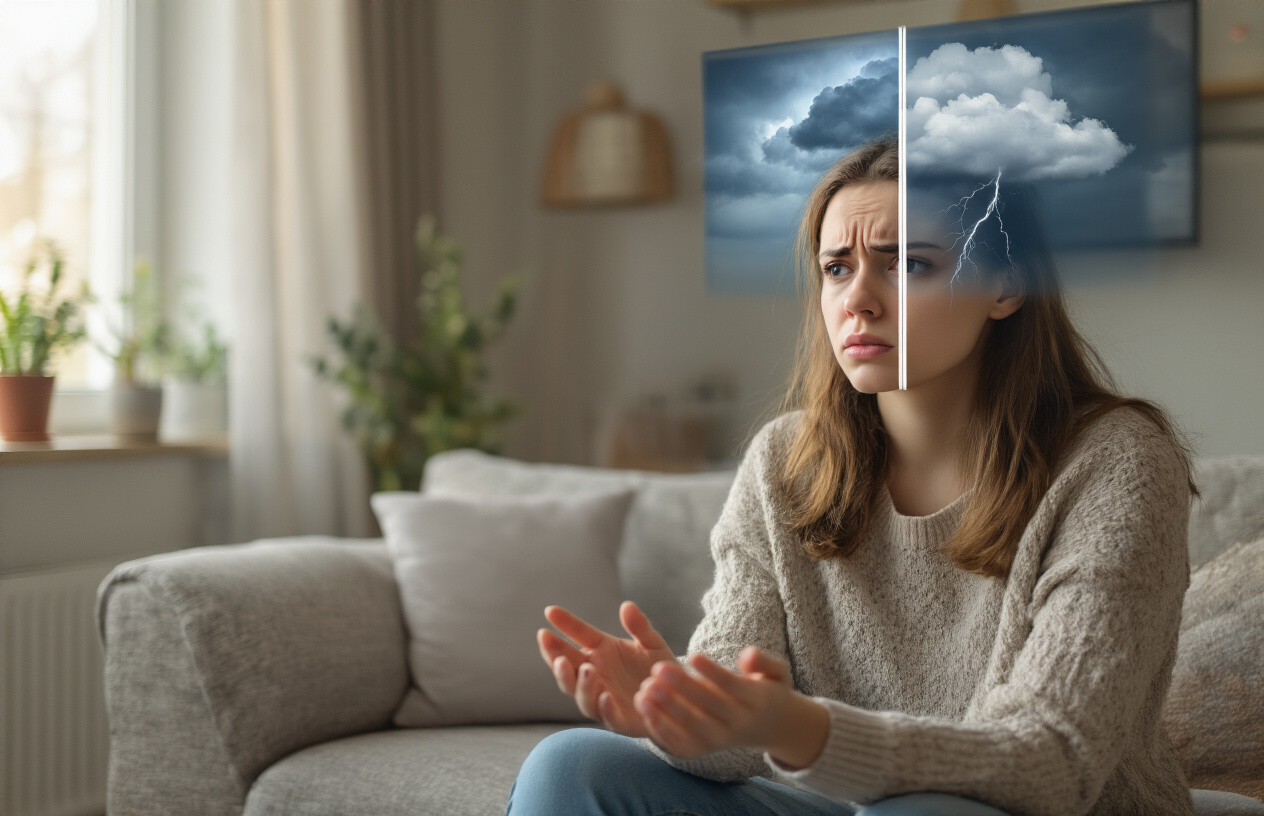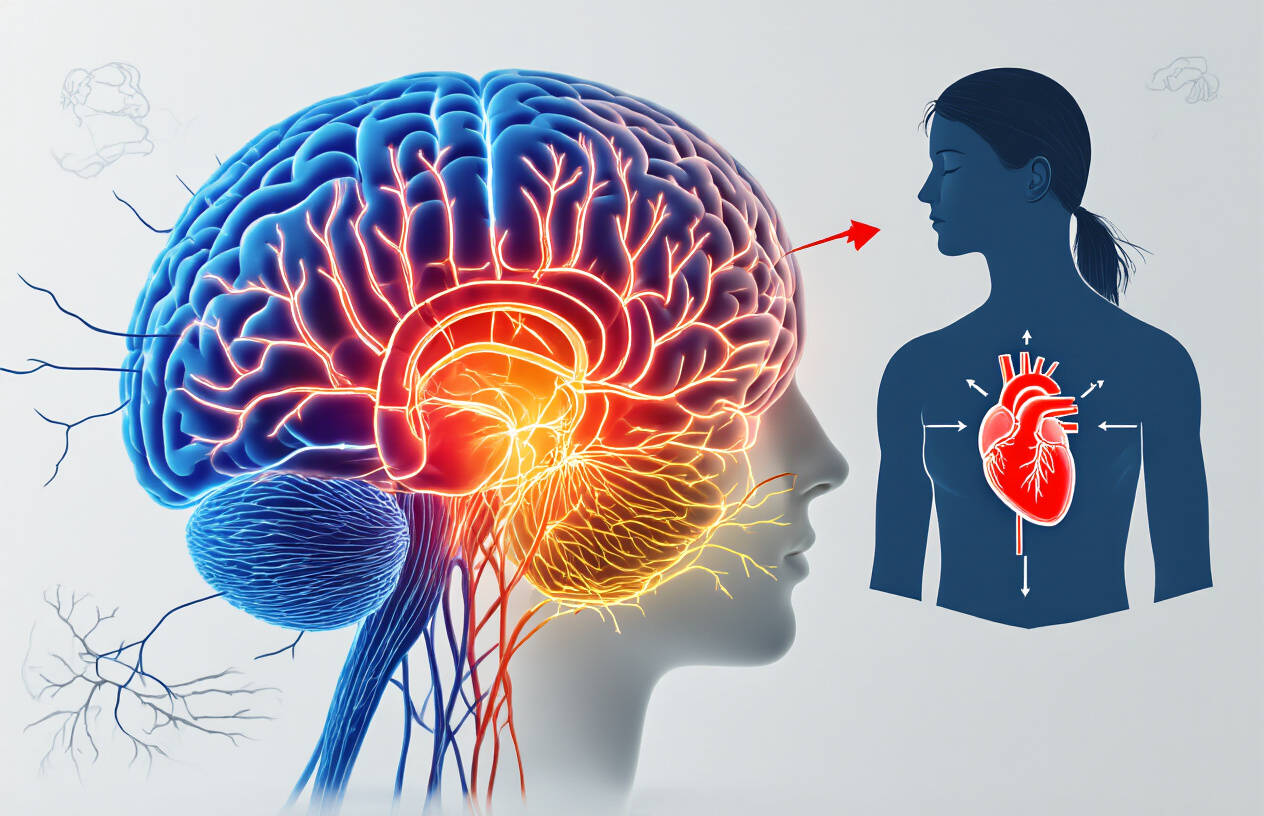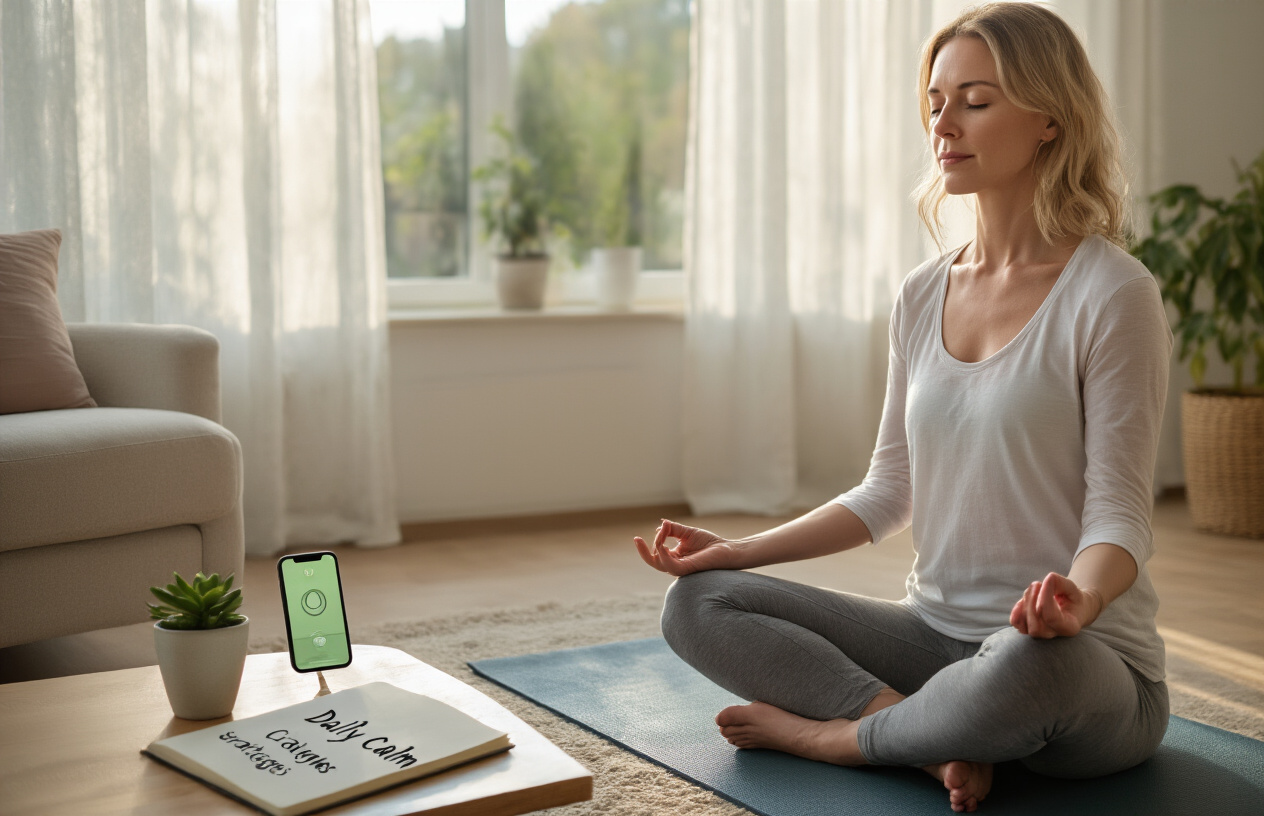Heart racing, triumphs sweating, and mind racing with worst- case scripts. Sound familiar? You are not alone. Anxiety diseases affect 40 million American grown-ups — that means nearly 20 of the population is feeling exactly what you are feeling right now.
I have spent times studying anxiety, both tête-à-tête and professionally. So I can tell you one thing understanding your anxiety is the first step in working with anxiety.
In this companion, we’ll talk about what is actually going on in your brain when you have anxiety attacks, what types of anxiety may be affecting you, and more importantly, what are some effects that have been proven to help you find your way back to calm.
The good news? You do not have to white- knuckled fall through this presently. Then’s what utmost croakers will not tell you about anxiety
Understanding Anxiety: What It Is and Isn’t

A. Distinguishing Between Normal Anxiety & Anxiety diseases
Distinguishing Between Normal Anxiety & Anxiety diseases
Every bone of us may feel anxious occasionally. That butterfly feeling before a job interview is normal anxiety furnishing you with a sensible service- to keep you alert and prepare you to take action. still, there’s a threshold beyond which day- to- day worries come commodity more serious.
Normal anxiety is the brain’s erected- in alarm system it’s temporary and contextual and can indeed ameliorate performance. For case, your donation makes you nervous, but you feel okay once the donation is done.
Anxiety diseases, on the other hand, turn the alarm system on itself it sounds a 10- alarm fire when there is no reason to be bothered. The solicitude becomes inordinate and lasts for months. An anxiety complaint takes your diurnal conditioning and balls them up like a piece of paper and throws them in the trash.
B. Overview of Common types Anxiety diseases
Generalized Anxiety complaint( GAD) Think of GAD as endlessly fussing about any and everything that could go wrong — plutocrat, health, work, indeed though everything is fine. GAD is solicitude that persists and is violent, and indeed when you want to shut it off, you ca n’t.
Social Anxiety complaint This is beyond being shy. individualities with social anxiety complaint experience violent fear of being judged while in social situations, which may beget them to avoid social gatherings altogether. fear complaint individualities with fear complaint experience inviting and violent fear as a result of direct and repeated occurrences of fear attacks, which are severe physical responses to what appears to be peril. fear attacks are frequently described as feeling like you’re either having a heart attack or” going crazy.
Specific Phobias individualities with specific phobias witness inviting fear of certain objects or situations similar as heights, flying, or spiders — that requires them tore-order their lives to avoid encountering those objects or situations.
compulsive-obsessive complaint( OCD) You might have learned that compulsive- obsessive individualities are driven by unwanted studies( prepossessions) that beget them to engage in repetitious conduct( forces) to help exclude passions of anxiety. still, the forces generally relieve anxiety only temporarily and increase it overall.
C. Feting Physical, Emotional, and Behavioural Symptoms
Your body speaks volumes when anxiety takes hold. Physically, you might notice:
- contending heart and briefness of breath
- Stomach issues and nausea
- Muscle pressure and headaches
- Fatigue yet trouble sleeping
- inordinate sweating
Emotionally, anxiety shows up as :
- Constant solicitude and dread
- Feeling on edge or perverse
- Difficulty concentrating
- contending studies you can not control
- Anticipating the worst possible issues
Behaviorally, you might find yourself :
- Avoiding anxiety- driving situations
- Seeking inordinate consolation from others
- Procrastinating on opinions
- tone- bandaging with alcohol or substances
- passing restlessness or incapability to relax
Feting these symptoms is your first step toward getting better. They are not character excrescencies or signs of weakness — they’re signals that your body’s alarm system needs recalibration. Get complete info here
The Biology of Anxiety: Why Our Bodies React

How the” Fight or Flight” Response Works
Ever wondered why your heart races when you are anxious? That is your body’s ancient survival medium remonstrating in. When your brain perceives a trouble( real or imagined), it triggers a waterfall of hormones — primarily adrenaline and cortisol — that prepare you to either fight the peril or run from it.
This response happens lightning- fast. Your breathing quickens to get further oxygen. Your heart pumps harder to shoot blood to your muscles. Your digestion slows down( who needs to digest when there is peril?). And your senses edge.
The problem? This system evolved for physical pitfalls like bloodsuckers, not ultramodern stressors like work deadlines or social media. When touched off constantly for cerebral pitfalls, this response can wear your body down. Complete guideline
The part of Brain Chemistry in Anxiety
Your brain is principally a chemical plant, and anxiety happens when product goes a bit haywire. Neurotransmitters — the brain’s chemical couriers play a huge part then.
GABA( gamma- aminobutyric acid) acts like your brain’s natural painkiller, calming nervous exertion. People with anxiety frequently have lower GABA situations or receptors that do not respond well to it. Serotonin helps regulate mood, sleep, and appetite. When situations drop too low, anxiety and depression can creep in. That is why numerous anxiety specifics( SSRIs) work by boosting serotonin. Norepinephrine cranks up alertness and thrill. Too important during stress can amplify anxiety symptoms.
Genetic Factors and Family Patterns
Got anxious cousins? also you might have inherited further than just your mama ‘s eye color. exploration shows anxiety diseases run in families, with heritability estimates between 30- 50. Specific genes linked to anxiety regulate how your brain processes sweat and stress. Some people inherit a more sensitive alarm system that goes out too fluently or too intensively. But genetics is not fortune. Your DNA loads the gun, but terrain pulls the detector. Growing up with anxious parents can also educate anxious actions through modeling. kiddies learn by watching how grown-ups respond to stress.
How Stress Triggers Anxiety Responses
Stress and anxiety are mates in crime, but they are not identical. Stress is your response to a specific situation. Anxiety is when solicitude persists after the stressor is gone.
Your body can not tell the difference between physical peril and cerebral pressure. Each stressful situation — from business logjams to tense meetings — can spark the same natural waterfall. habitual stress keeps your body in a constant state of high alert.
Over time, this wears down your natural adaptability. Your stress threshold lowers, making it easier for everyday situations to spark anxiety. This explains why you might handle stress well for months, also suddenly find yourself scarifying over commodity small. It’s not that final stressor it’s the accretive effect of all the stress that came before it.
Effective Management Strategies for Daily Anxiety

Awareness and Breathing ways Anyone Can Master
Anxiety hits hard and fast. One nanosecond you are fine, the coming your heart’s racing and your mind’s spinning out of control. But then is the thing your breath is always with you, ready to be your anchor.
The 4-7-8 fashion works prodigies when fear starts creeping in. Breathe in for 4 seconds, hold for 7, and exhale sluggishly for 8. That is it. Simple enough to do anywhere — at your office, in a crowded train, or lying in bed at 3 AM when worries will not quit.
Box breathing is another game- changer. Imagine tracing a square with your breath inhale( 4 counts), hold( 4 counts), exhale( 4 counts), hold( 4 counts). Repeat this a many times and watch your nervous system calm down in real time.
Body checkup contemplations do not bear fancy outfit or hours of your day. Just close your eyes and sluggishly bring mindfulness to each part of your body, noticing sensations without judgment. Start at your toes and work up to the top of your head. Ten twinkles of this can reset your entire nervous system.
The 5-4-3-2-1 grounding fashion pulls you back when anxiety has you floating down:
- 5 effects you can see
- 4 effects you can touch
- 3 effects you can hear
- 2 effects you can smell
- 1 thing you can taste
Just naming these effects reconnects you to the present moment, cutting anxiety off at the knees.
Physical Exertion as a Natural Anxiety Reducer
Your body was designed to move, not to sit scrolling through anxiety- converting captions all day. The exploration is crystal clear clear — just 30 twinkles of moderate exercise can reduce anxiety symptoms nearly incontinently. Walking might feel too simple to be effective, but it’s actually a hustler anxiety joker.
A brisk 20- nanosecond walk sends endorphins submerging through your system, creating that natural” feel good” sensation that can last for hours. No outfit demanded, just a brace of decent shoes and nearly to put one bottom in front of the other.
Yoga combines movement with breath work, delivering a one- two punch to anxiety. The Child’s disguise, Forward Fold, and Legs- Up- The- Wall disguise specifically target the nervous system, cranking your body’s relaxation response. Indeed five twinkles in these acts can shift your entire internal state. Strength training is not just for structure muscle — it builds internal adaptability too.
The focus needed to perform exercises with proper form does not leave important room for anxious studies. Plus, the progressive nature of strength gains glasses the way we can gradationally strengthen our capability to handle stress. High- intensity interval training( HIIT) creates a important” later- burn” effect that can keep anxiety at bay for hours. Those short bursts of violent trouble followed by recovery ages image the meter of literacy to manage with anxiety — facing intensity, also chancing relief. cotillion it out when you are too anxious to suppose straight. Put on music that moves you and just let your body respond. No choreography demanded the most effective anxiety- busting movements are the bones
that feel good in your body right now.
Diet and Lifestyle Changes That Make a Difference
What you put in your body directly impacts your anxiety situations — this is not just heartiness fluff, it’s neuroscience. Your brain needs specific nutrients to manufacture the neurotransmitters that regulate mood and anxiety.
Caffeine might be sabotaging your anxiety operation sweats. That morning coffee triggers the same fight- or- flight response that anxiety does, basically mimicking anxiety symptoms. Try cutting back gradationally — cold lemon can spark headaches that make anxiety worse.
Magnesium-rich foods earn further space on your plate. Dark chocolate, avocados, nuts, and lush flora all contain this mineral that acts like nature’s bite lozenge. It regulates neurotransmitters, relaxes muscles, and calms the nervous system. The gut- brain connection is real and important.
Fermented foods like yogurt, kimchi, and kombucha support your gut microbiome, which directly communicates with your brain via the vagus whim-whams. A healthier gut frequently means a calmer mind.
Sugar creates energy harpoons and crashes that can spark or worsen anxiety symptoms. I am not saying noway enjoy a cookie again, but being aware of when and how important sugar you consume can help those anxiety- converting blood sugar rollercoasters.
Alcohol seems like it helps anxiety in the moment, but it’s actually making effects worse in the long run. It disrupts sleep cycles and alters brain chemistry, frequently leading to increased anxiety as it wears off — the dreaded” hangxiety.”
Sleep Hygiene Practices for Anxiety Relief
Poor sleep and anxiety feed each other in a vicious cycle. Breaking this pattern starts with creating a harmonious sleep schedule — yes, indeed on weekends. Your body craves routine, and a regular sleep- wake cycle helps regulate the hormones that impact anxiety.
The blue light from defenses suppresses melatonin product, making it harder to fall asleep. produce a digital evening by turning off defenses at least an hour before bed.However, at least use blue light blocking spectacles or screen pollutants, If that sounds insolvable.
Your bedroom should be a sanctuary, not a multipurpose space. Keep it cool( around 65 °F/ 18 °C), dark, and quiet. Blackout curtains, white noise machines, and comfortable coverlet are not luxuries when you are battling anxiety — they’re essential tools.
Pre-sleep rituals gesture to your brain that it’s time to wind down. This could be as simple as a warm shower, gentle stretching, or reading commodity light. The key is thickness — do the same comforting conditioning in the same order each night. contending studies keeping you awake? Keep a tablet by your bed to jot them down. This simple act tells your brain” I have got this handled” so it can stop the internal spinning.
Sleep apps like Calm, Headspace, and Slumber offer guided sleep contemplations and stories specifically designed to quiet anxious minds. occasionally having someone differently’s voice to concentrate on breaks the cycle of anxious thinking.
Technology Tools and Apps for Anxiety operation
Technology is not all doom- scrolling and sleep dislocation — the right digital tools can actually help manage anxiety effectively. Tracking apps like Daylio and MoodKit help you identify patterns in your anxiety triggers, giving you data to work with rather of just passions to fight against.
Contemplation apps have evolved far beyond introductory timekeepers. Headspace offers specific anxiety- concentrated contemplation series, while Calm’s body checkup contemplations can pull you out of an anxiety curl in twinkles. sapience timekeeper has thousands of free contemplations, numerous specifically for anxiety operation.
Breathe2Relax and Breath Ball companion you through specific breathing exercises proven to spark your parasympathetic nervous system the body’s erected- in anxiety reducer. The visual guidance makes it easier to concentrate when anxiety has scattered your attention.
Virtual remedy platforms like BetterHelp and Talkspace have made professional help more accessible than ever. numerous offer messaging options for those moments when anxiety harpoons between sessions.
Biofeedback bias like the Muse headband or Apollo Neuro wristband give real- time data about your physical stress responses, helping you fete and manage anxiety before it overwhelms you.
ASMR vids might feel strange if you’ve noway tried them, but numerous people find the gentle sounds and concentrated attention incredibly soothing for anxiety. The tingles and relaxation they produce can intrude anxiety’s physical grip on your body.
Professional Treatment Options

A. When Self-Help Isn’t Enough: Recognizing the Signs
Sometimes those breathing exercises and morning runs just don’t cut it. Your anxiety might need professional attention if:
- You avoid important activities or can’t function in daily life
- Your anxiety persists for 6+ months despite self-help efforts
- Physical symptoms like chest pain or insomnia are severe
- You’re experiencing panic attacks that seem to come from nowhere
- Your relationships or work are suffering significantly
- You’re using alcohol or drugs to cope with your feelings
- You’re having thoughts of harming yourself
Trust your gut. If anxiety feels too big to handle alone, it probably is.
B. Types of Therapy Proven to Help Anxiety
Not all therapy approaches work the same for anxiety. These have the strongest track record:
Cognitive Behavioral Therapy (CBT): The gold standard. CBT helps you identify thought patterns driving your anxiety and replace them with healthier alternatives. Most people see improvement in 12-16 sessions.
Exposure Therapy: Particularly effective for phobias and OCD. You’ll gradually face feared situations in a controlled, supportive environment.
Acceptance and Commitment Therapy (ACT): Teaches you to accept anxiety sensations while still moving toward your values and goals.
EMDR: Uses eye movements to process traumatic memories that might be fueling anxiety.
C. Medication Options and What to Expect
Medication isn’t giving up—it’s often the bridge you need while developing coping skills. Common options include:
| Medication Type | How They Work | Typical Timeline | Common Side Effects |
|---|---|---|---|
| SSRIs/SNRIs (Lexapro, Zoloft) | Regulate brain chemicals | 4-6 weeks to full effect | Initial increased anxiety, digestive issues |
| Benzodiazepines (Xanax, Klonopin) | Fast-acting anxiety relief | Works within minutes | Drowsiness, risk of dependence |
| Buspirone | Reduces anxiety with less sedation | 2-4 weeks | Dizziness, headaches |
| Beta-blockers | Block physical symptoms | Works same day | Low blood pressure |
Remember: side effects often improve after the first few weeks, and dosages can be adjusted to minimize them.
D. Finding the Right Mental Health Professional
Finding the right provider feels like dating—chemistry matters. Start here:
- Ask for referrals from your doctor, friends, or insurance company
- Check credentials (therapists, psychologists, psychiatrists have different training)
- Consider specialization in anxiety disorders specifically
- Interview potential providers about their approach and experience
- Trust your comfort level during initial sessions
Many therapists offer free consultation calls. Use them! Ask about their experience with anxiety, their treatment approach, and what success typically looks like.
Don’t get discouraged if the first professional isn’t a good fit. Finding the right match sometimes takes a few tries, but the relief when you do is worth it.
Building Long-Term Resilience to Anxiety

Creating a Personalized Anxiety Management Plan
Anxiety isn’t one-size-fits-all, so why should your approach to managing it be? Building your own anxiety toolkit starts with understanding your unique triggers and symptoms.
Start by keeping a simple anxiety journal. Track when anxiety hits, what you were doing, and how intense it felt on a scale of 1-10. After a week, patterns will emerge that help you identify your personal triggers.
Next, experiment with different coping techniques. Some people find relief through deep breathing, while others need physical movement or creative outlets. The goal is discovering what works specifically for you.
Your plan should include:
- Daily preventative practices (like morning meditation)
- Quick relief strategies for acute anxiety moments
- Long-term resilience builders (therapy, regular exercise)
Remember to adjust your plan as needed. What works during work stress might differ from what helps with social anxiety.
Developing Healthy Thought Patterns
Our minds can be our worst enemies when it comes to anxiety. Recognizing and reshaping unhelpful thinking habits is key to long-term anxiety management.
Common anxiety thought traps include:
- Catastrophizing (“This headache must be a brain tumor”)
- Mind-reading (“Everyone at this party thinks I’m awkward”)
- All-or-nothing thinking (“If I don’t get this perfect, I’m a total failure”)
To break these patterns, try the ABCD method:
- Aware: Notice the anxious thought
- Breathe: Take a moment to center yourself
- Challenge: Question the thought’s accuracy
- Different perspective: Generate a more balanced view
With practice, you’ll catch unhelpful thoughts faster and redirect them more easily. Your brain is rewiring itself each time you choose a healthier thought pattern.
Building a Supportive Community
Anxiety thrives in isolation. Creating connections with understanding people provides emotional safety nets when anxiety storms hit.
Start small by identifying one or two trusted people you can be honest with about your anxiety. Clear communication helps—explain what anxiety feels like for you and specific ways they can support you during difficult moments.
Online communities can supplement in-person connections. Groups focused on anxiety provide 24/7 understanding from people who truly “get it.”
Support comes in many forms:
- Someone to listen without trying to “fix” you
- An accountability partner for anxiety management practices
- A friend who helps you face anxiety-inducing situations gradually
The strongest support networks include people who respect your journey while gently encouraging your growth.
Preventing Anxiety Relapse
Even as you build resilience, anxiety might occasionally resurface. The difference now? You’ll have strategies ready.
Watch for early warning signs—sleep changes, increased worry, avoiding activities—and respond before anxiety regains its grip. This might mean temporarily increasing self-care practices or reconnecting with a therapist.
Create a “future self” letter during a calm period. Write down what helped you overcome anxiety before and words of encouragement. Save this for times when anxiety clouds your memory and hope.
Maintain a consistent routine that prioritizes:
- Regular sleep patterns
- Balanced nutrition
- Physical movement
- Meaningful social connection
- Activities that bring genuine joy
The goal isn’t to never feel anxious again—that’s unrealistic. Instead, aim to build a life where anxiety no longer controls your choices or diminishes your joy.

Anxiety affects millions worldwide, but with the right understanding and tools, it can be effectively managed. By feting the difference between normal solicitude and anxiety diseases, understanding the natural mechanisms behind our anxious responses, and enforcing harmonious managing strategies, you can gradationally reduce anxiety’s impact on your life. Whether through awareness practices, physical exertion, healthy life choices, or cognitive behavioral ways, there are multitudinous approaches to find what works best for you.
Flash back that seeking professional help is a sign of strength, not weakness. Therapists, counselors, and medical professionals offer precious guidance and treatment options that can significantly ameliorate your quality of life. structure adaptability to anxiety is a trip that takes time and tolerance, but with each small step, you move closer to a calmer, more balanced state of mind. You are not alone in this trip – reach out, practice tone- compassion, and celebrate every palm along the way.

